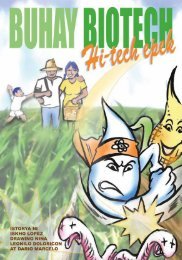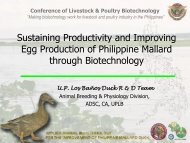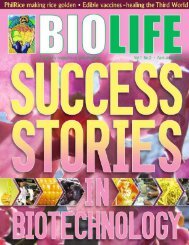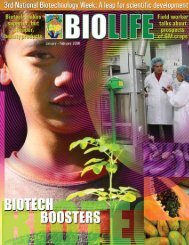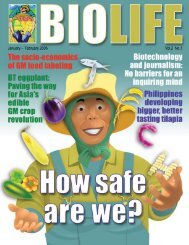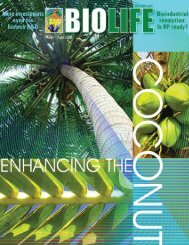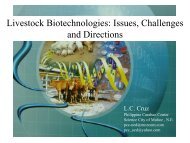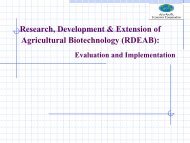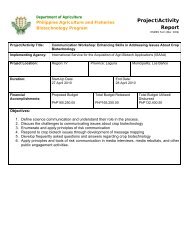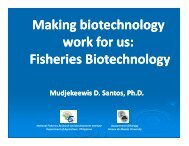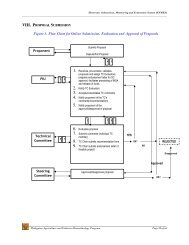Download PDF - SEARCA Biotechnology Information Center
Download PDF - SEARCA Biotechnology Information Center
Download PDF - SEARCA Biotechnology Information Center
You also want an ePaper? Increase the reach of your titles
YUMPU automatically turns print PDFs into web optimized ePapers that Google loves.
16 BIO LIFE January – March 2005<br />
AFTER ONE YEAR OF COMMERCIAL ADOPTION:<br />
By LYN RESURRECCION<br />
THE debate on biotechnology, or specifi<br />
cally on genetically modified organisms<br />
(GMOs), has quieted down in the past year<br />
from the fever-pitch level of more than two<br />
years ago, although the opposition against<br />
the modern technology that is seen to dominate<br />
the new millennium still persists.<br />
At the center of the debate in the country<br />
was the controversial Bt (Bacillus<br />
thuringiensis) corn, the product of a process<br />
where the Bt protein found in the soil is integrated<br />
into the corn plant to equip it with a<br />
high degree of resistance to the damaging<br />
Asian corn borer.<br />
Critics oppose the technology in the<br />
name of human safety and the environment,<br />
despite the scientists’ persistent denials<br />
of such peril, and painstaking explanations<br />
that there has been no evidence to<br />
that effect.<br />
But, at least, so far for now, the days of<br />
plant pulling, such as in the Bt corn field<br />
trial in Tampakan, South Cotabato, and the<br />
emotion-filled rallies or fora against the<br />
technology, have passed.<br />
Since the Department of Agriculture approved<br />
in December 2002 the commercial<br />
release of Bt corn, what have been seen<br />
and heard are testimonies in favor of the<br />
main beneficiaries of the technology—the<br />
farmers—on the advantages of the use of<br />
Bt corn. In a paper at the 45th National<br />
PAEDA Convention in Quezon City in October,<br />
entitled, “Economic Impact of Bt Corn<br />
in the Philippines,” Jose M. Yorobe Jr., assistant<br />
professor of the Department of Agricultural<br />
Economics at the University of the<br />
Philippines Los Baños, said that after one<br />
year of commercial adoption in only about<br />
10,000 hectares planted to Bt corn in the<br />
country, substantial unit-yield increase of<br />
as much as 37 percent was realized by the<br />
Bt corn farms.<br />
“This translates to an additional profit<br />
of P10,132 per hectare with a reduction in<br />
insecticide expenditures of 60 percent. An<br />
incremental net income of P1.34 per kilogram<br />
was gained by the Bt corn users, al-<br />
though the seed cost was twice the ordinary<br />
hybrid,” Yorobe said in the paper. He<br />
acknowledged that the paper was part of a<br />
study by the International Service for the<br />
Acquisition of Agri-biotech Applications<br />
(ISAAA), a not-for-profit organization, on<br />
the impact of Bt corn in the Philippines.<br />
ISAAA centers are based in the Philippines,<br />
Kenya and the United States. He<br />
stressed that the adoption of Bt corn in the<br />
country, albeit still limited in time and<br />
hectarage, showed a significant impact on<br />
the farm financial performance as shown<br />
by the adoption elasticity that was even<br />
higher than those observed in developed<br />
countries. The Yorobe paper used data from<br />
the ISAAA survey, which interviewed 107<br />
Bt and 362 non-Bt corn farmers in the wet<br />
and dry seasons of crop-year 2003 and<br />
2004 in four major Bt-corn adopting provinces<br />
of Isabela, Camarines Sur, Bukidnon<br />
and South Cotabato.<br />
At least three towns and three<br />
barangays per town were chosen based on<br />
the density of Bt corn adopters.




